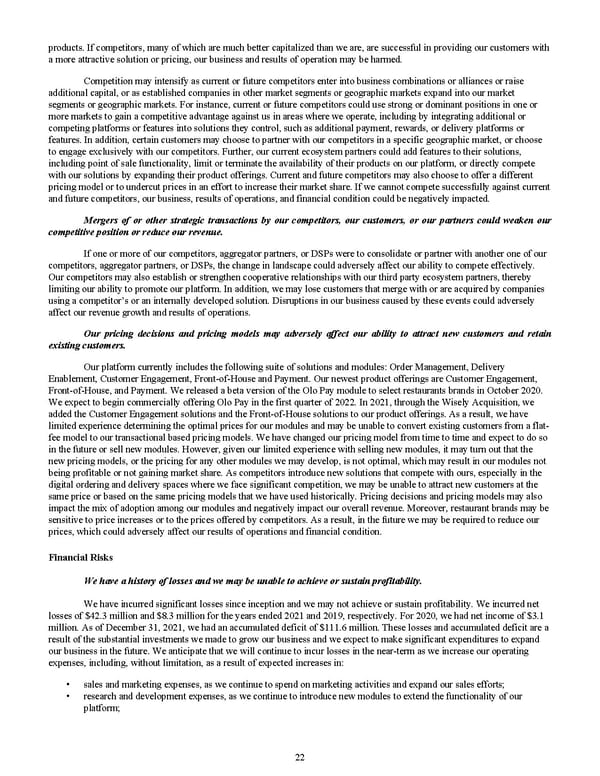products. If competitors, many of which are much better capitalized than we are, are successful in providing our customers with a more attractive solution or pricing, our business and results of operation may be harmed. Competition may intensify as current or future competitors enter into business combinations or alliances or raise additional capital, or as established companies in other market segments or geographic markets expand into our market segments or geographic markets. For instance, current or future competitors could use strong or dominant positions in one or more markets to gain a competitive advantage against us in areas where we operate, including by integrating additional or competing platforms or features into solutions they control, such as additional payment, rewards, or delivery platforms or features. In addition, certain customers may choose to partner with our competitors in a specific geographic market, or choose to engage exclusively with our competitors. Further, our current ecosystem partners could add features to their solutions, including point of sale functionality, limit or terminate the availability of their products on our platform, or directly compete with our solutions by expanding their product offerings. Current and future competitors may also choose to offer a different pricing model or to undercut prices in an effort to increase their market share. If we cannot compete successfully against current and future competitors, our business, results of operations, and financial condition could be negatively impacted. Mergers of or other strategic transactions by our competitors, our customers, or our partners could weaken our competitive position or reduce our revenue. If one or more of our competitors, aggregator partners, or DSPs were to consolidate or partner with another one of our competitors, aggregator partners, or DSPs, the change in landscape could adversely affect our ability to compete effectively. Our competitors may also establish or strengthen cooperative relationships with our third party ecosystem partners, thereby limiting our ability to promote our platform. In addition, we may lose customers that merge with or are acquired by companies using a competitor’s or an internally developed solution. Disruptions in our business caused by these events could adversely affect our revenue growth and results of operations. Our pricing decisions and pricing models may adversely affect our ability to attract new customers and retain existing customers . Our platform currently includes the following suite of solutions and modules: Order Management, Delivery Enablement, Customer Engagement, Front-of-House and Payment. Our newest product offerings are Customer Engagement, Front-of-House, and Payment. We released a beta version of the Olo Pay module to select restaurants brands in October 2020. We expect to begin commercially offering Olo Pay in the first quarter of 2022. In 2021, through the Wisely Acquisition, we added the Customer Engagement s olutions and the Front-of-House solutions to our product offerings. As a result, we have limited experience determining the optimal prices for our modules and may be unable to convert existing customers from a flat- fee model to our transactional based pricing models. We have changed our pricing model from time to time and expect to do so in the future or sell new modules. However, given our limited experience with selling new modules, it may turn out that the new pricing models, or the pricing for any other modules we may develop, is not optimal, which may result in our modules not being profitable or not gaining market share. As competitors introduce new solutions that compete with ours, especially in the digital ordering and delivery spaces where we face significant competition, we may be unable to attract new customers at the same price or based on the same pricing models that we have used historically. Pricing decisions and pricing models may also impact the mix of adoption among our modules and negatively impact our overall revenue. Moreover, restaurant brands may be sensitive to price increases or to the prices offered by competitors. As a result, in the future we may be required to reduce our prices, which could adversely affect our results of operations and financial condition. Financial Risks We have a history of losses and we may be unable to achieve or sustain profitability. We have incurred significant losses since inception and we may not achieve or sustain profitability. W e incurred net losses of $42.3 million and $8.3 million for the years ended 2021 and 2019 , respectively. For 2020 , we had net income of $3.1 million . As of December 31, 2021 , we had an accumulated deficit of $111.6 million . These losses and accumulated deficit are a result of the substantial investments we made to grow our business and we expect to make significant expenditures to expand our business in the future. We anticipate that we will continue to incur losses in the near-term as we increase our operating expenses, including, without limitation, as a result of expected increases in: • sales and marketing expenses, as we continue to spend on marketing activities and expand our sales efforts; • research and development expenses, as we continue to introduce new modules to extend the functionality of our platform; 22
 2022 10K Page 28 Page 30
2022 10K Page 28 Page 30